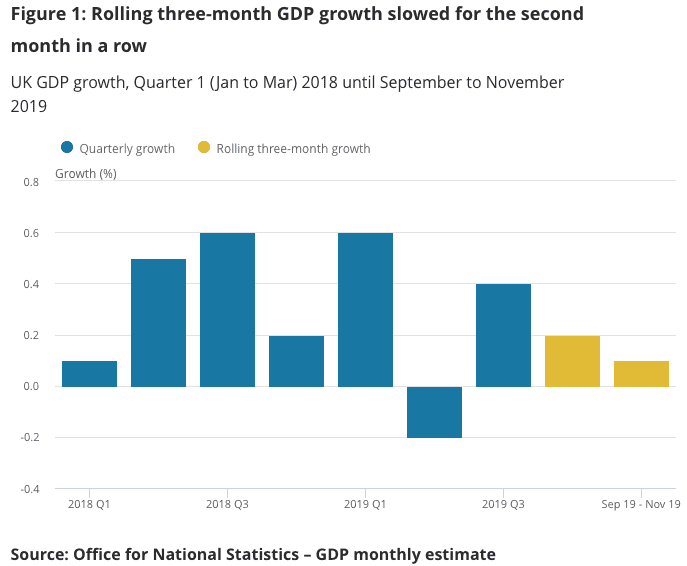Economy Shrank in November Shows Latest GDP Data, Paves Way to an Interest Rate Cut

Image © Adobe Stock
- GDP shrinks in Nov.
- Manufacturing slump deepens
- Bank of England have window of opportunity to cut rates
GDP data for November - out on Monday morning - showed that the UK economy contracted 0.3% that month. The ONS also reports that manufacturing production slumped 1.7%, much deeper than the 0.3% contraction that had been predicted by markets.
The data provide further signs the UK economy slowed sharply in 2019, and unless there are signs of a clear pickup in economic activity following the UK General Election, the Bank of England will likely cut interest rates.
GDP's decline of 0.3% in November means the rolling annual growth rate stood at 0.6%, meaning the economy continues to perform at below-trend levels.
But, the ONS reports that the UK economy grew slightly more strongly in September and October than was previously estimated, "with later data painting a healthier picture," says Rob Kent-Smith, Head of GDP at the ONS. "Overall, the economy grew slightly in the latest three months, with growth in construction pulled back by weakening services and another lacklustre performance from manufacturing."
Rolling quarterly economic growth - i.e. the three months to end-November - grew 0.1%, this is better than the -0.1% expected by the market.
"November probably represents peak uncertainty for the UK economy; Brexit had just been delayed again and the country was in the midst of what was predicted to be a close-run general election," says Cathal Kennedy, Europeean Economist with RBC Capital Markets. "What limited, mainly survey, data we have to hand suggest that the removal of those combined uncertainties has had a positive effect on consumer and business sentiment."
"Long term, the economy continues to slow, with growth in the economy compared with the same time last year at its lowest since the spring of 2012," adds Kent-Smith.
The services and production sectors contributed positively to GDP growth in the three months to November 2019, growing by 0.1% and 1.1%, respectively. However, the production sector fell by 0.6% in the same period, its second consecutive rolling three-month decline.
????????Annual growth in UK monthly GDP is now below 0.5% y/y - not seen since the European debt crisis in 2011-13!!
— Danske Bank Research (@Danske_Research) January 13, 2020
Supports the case for a BoE rate cut. Recent BoE comments have been dovish => investors think a rate cut later this month is basically a coin flip! pic.twitter.com/1fw5ELXAVH
Manufacturing output provided by far the largest downward contribution to an overall fall in industrial production, falling by 0.8%, led by widespread weakness throughout the sector, with negative contributions from 10 of the 13 sub-sectors.
According to the ONS, basic pharmaceutical products fell by 6.2%, mainly because of monthly weakness during September 2019
Transport equipment fell by 1.6%, caused by weakness from motor vehicles, trailers and semi-trailers, which fell by 2.4% because of the additional impact of shutdowns during November 2019.
"This industry is still showing a longer-term decline, as highlighted by the three months on same three months a year ago indicator, which fell by 3.1%," reports the ONS.
Chemicals and chemical products fell by 2.5%, partially because of the impact of maintenance and shutdowns but also because of widespread weakness in November and a continuation of sustained weakness since the three months to March 2019.
Neil Wilson, Chief Market Analyst at Markets.com, says it is "worth remembering that this data is backward looking and before the Tory victory, but this only adds to the sense that the BoE has a neat window of opportunity to cut this month."
Wilson says there is a sense the Bank doesn’t want to get behind the curve of market expectations, and is seeking to get a jump on markets whilst still teeing up the cut.
"It would be following the Fed’s playbook in cutting early in order to prevent a downturn. This is the key thing to remember – the Bank does not want to let a weaker economy fester," says Wilson, adding:
"Whilst there is no trade deal with the EU, the MPC has been largely released from the shackles of Brexit uncertainty following the Conservative victory last month. Political risk has hobbled the MPC but this has diminished greatly and now is the window – before a possible clash with the EU in the spring that would make policy changes more political in nature – to get a cut in the bag to juice the economy. .




